If you’ve never worked with fresh turmeric, then you’re not alone. And although most folks may have a container of powdered turmeric in their spice rack, it’s not typically a daily-use item. We are here to spice up your life in a fresh way with a new favorite ingredient. Turmeric is an incredible superfood that studies have shown can reduce inflammation that may cause chronic diseases — but it also can enhance the look and flavor of almost any dish, sweet or savory. If you’re not a fan of the powdered version, just know that there is a difference between dried and fresh turmeric, so it’s worth giving the actual root a try.
Fresh turmeric looks quite a bit like ginger, but with bright yellow or orange coloring, and a tender skin. While you may find dried turmeric to be quite subdued, fresh turmeric has a more pronounced taste that will make a bigger impact on your dish. In addition, the fresh version tends to have a more vibrant color and can be used in a plethora of ways that turmeric powder just can’t.
Head to your local co-op, farmer’s market, or health food store and grab a few roots to get started. Pro tip: Pair turmeric with a little bit of black pepper to help enhance the absorption of its active compound, curcumin, in your system.
Use turmeric in a stir-fry
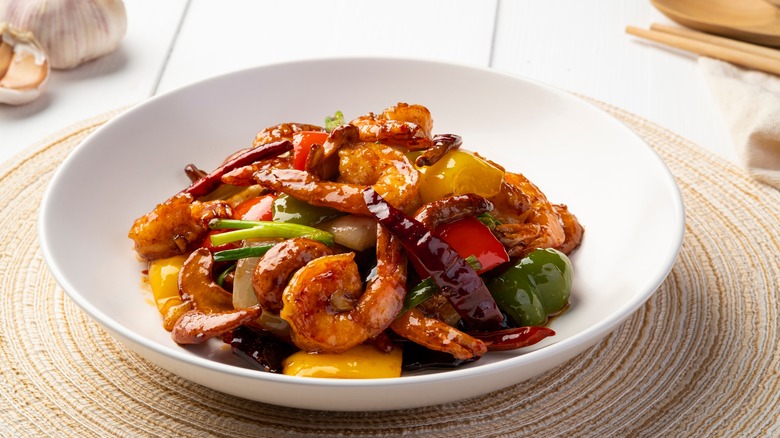
The turmeric root has a fresh, earthy flavor with subtle peppery notes, making it slightly spicy. Turmeric can boost umami flavor, so it’s a perfect addition to a stir-fry. However, turmeric root has the consistency of ginger root, and is very fibrous. Therefore, it’s not an option to simply add large chunks of the plant into your pan and expect your creation to be palatable. Instead, consider cutting it into ultra-thin slices (think the width of pickled ginger), grate it, or mince it. You can also cut it into tiny matchstick-sized pieces, which can appear quite aesthetically pleasing.
Keep in mind that turmeric, especially when fresh, will dye anything it comes in contact with — including your cutting board, wooden spoons, and even your hands. Try using white vinegar mixed with warm water and dish soap to get the yellow coloring off of your hands and utensils. Because of this coloring effect, any bright vegetables or meats in your stir-fry will instantly be given a rich and beautiful yellow tint.
Dye your dish
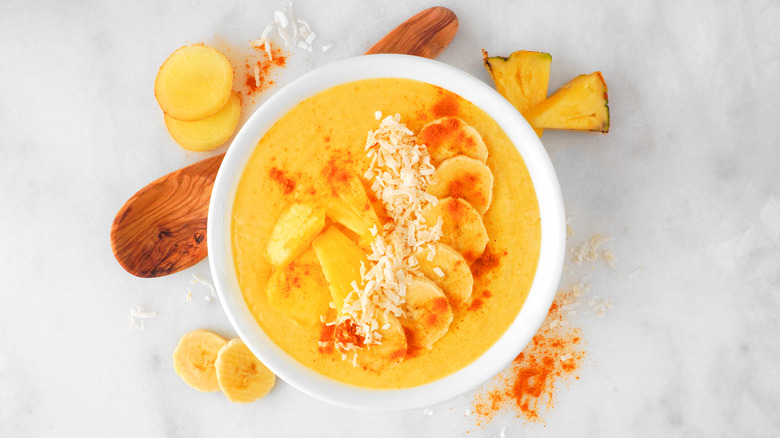
Turmeric’s ability to dye anything it comes in contact with can be a blessing or a curse. And while this factor doesn’t make for easy cleanup, the root can be used to dye your food for aesthetic purposes, while making only a mild dent in the flavoring. Grated or juiced turmeric can be mixed with yogurt, frosting, cottage cheese, cauliflower bisque, or cashew cream in order to help your dish sing. This is one of the popular plants used for natural dye both in and outside of the culinary world, and turmeric can even be used to DIY your own natural tie-dye liquid.
Consider using turmeric juice or grated turmeric to dye Easter eggs, to give your scrambled eggs an extra-bright pop, or to create colorful frostings for your cakes, cupcakes, or cookies. Just a few drops of turmeric juice will do the trick. To add gusto to a plain white plate, simply slice the turmeric root and rub the exposed flesh on the dish before plating your food.
Blend turmeric into a smoothie

Souvik Sarkar Photography/Shutterstock
Smoothies are notorious for being an everything-but-the-kitchen-sink kind of drink. Often they include more than just fruit, such as vegetables, spices, nuts, and even grains like oatmeal. Because of its mild flavor, fresh turmeric can add an antioxidant-rich nutritional boost without changing your creation in the flavor department. As you might do with ginger, just add a slice about the size of your thumbnail to fruit- or vegetable-based smoothies, and let your blender do the magic. Don’t forget to sprinkle in a small dash of pepper to boost the nutritional benefits.
For a beautiful smoothie that will look like blended sunshine, add turmeric to light-colored smoothies that have a milk or plant-milk base. Choose ingredients like banana, yogurt, mango, pineapple, or avocado over dark berries. Grate a little fresh turmeric on top as garnish, and be sure to use a straw so you don’t dye your lips yellow.
Make a colorful dressing
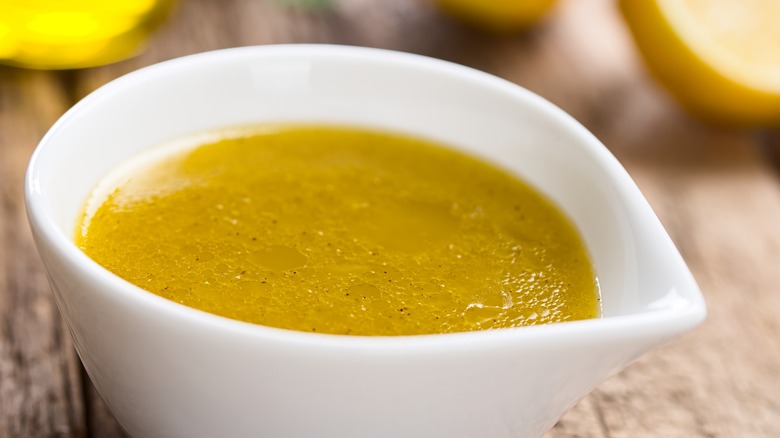
Ildi Papp/Shutterstock
In the spring and summertime, it can be so nice to sit down to a dish overflowing with color and whimsical energy. Sprouts, thinly sliced citrus fruits, and edible flower petals can achieve this aesthetic, but there is another option to bring life into your dish. Try mixing grated turmeric or fresh turmeric juice into your salad dressing. This can work for vinaigrettes for a sophisticated and subtle pop of color, or in a creamy dressing as a bold and beautiful addition.
Tahini dressings — loaded with lemon, , garlic, extra virgin olive oil, and honey or maple syrup — pair well with the slightly peppery turmeric root. The light color of tahini allows the root’s bright yellow coloring to shine through. Consider using this as the perfect spice to give tahini dressings a colorful upgrade for both salads and roasted vegetables. It’s the perfect drizzle for veggies fresh off the grill during the summer months, and can bring a kale-and-cranberry salad to life in the fall.
Steep turmeric with your tea

Ollo/Getty Images
Folks typically drink tea for comfort, but this beverage’s health benefits are off the charts. Whether you choose black tea or prefer to steep herbs instead, it’s often an antioxidant-rich drink. Both fresh ginger and turmeric tend to make an appearance when it comes to this hot drink, either as a leading actor or to complement the main ingredient.
Consider slicing fresh turmeric and steeping it in boiling water for about 15 minutes. The minimum steep time for fresh turmeric tea is around 10 minutes, but the longer you steep it, the more intense the concentration will be. The slices can be rather chunky, with the skin left on if you are planning to remove it before drinking, or it can be shaved in for these pieces to remain in the pot.
Although turmeric might stain your lips temporarily, it’s unlikely to stain your teeth, unless you make turmeric tea a part of your daily ritual. If you’re concerned about this, use a more diluted concentration. Sweeten your turmeric tea with honey and add some lemon. In the warmer months, chill it to enjoy the beverage cold.
Roast your turmeric
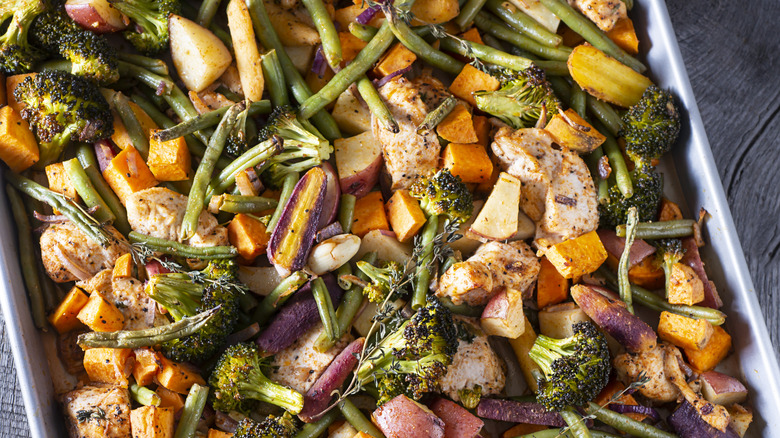
Rudisill/Getty Images
Sheet-pan dinners are popular for a reason. They are easy to prep, they’re hands-off, and you don’t have to worry about timing every portion to be done all at once. Root vegetables are popular in the roasting department, but we believe there is a root that gets left out all too often. Next time you’re making a sheet-pan dinner, instead of just sticking with beets, carrots, turnips, onions, and sweet potatoes, shoot turmeric an invite. The turmeric adds a little depth and color to any herb-roasted root vegetables recipe.
Because of turmeric’s chewy, fibrous texture, be sure to slice or cut your fresh root into thin matchstick-sized pieces. The turmeric sticks will cook a little more aggressively because of their size, but this will help to crisp them up so you won’t be chewing on them for days.
Don’t assume roasted turmeric root is to be used exclusively with root vegetables. Try it in your summer veggie medley as well, alongside red peppers, summer squash, corn, and cherry tomatoes.
Grate turmeric as a garnish

LN team/Shutterstock
Although fresh herbs dominate the garnish scene, try using fresh turmeric to add aesthetic appeal to your dishes. When sprinkled in a cluster on salads, smoothies, seafood, or soups, turmeric zest or finely grated turmeric can have an appearance like saffron or bee pollen — but it’s much less expensive, and can have a similar impact when it comes to the visual aspect of your dish.
Because of its bright color, juiciness, and peppery flavor, turmeric can be used as a garnish on both savory dishes and desserts. Next time you add icing to a cake, or frost cupcakes, consider sprinkling grated fresh turmeric on top for some texture and a pop of color. If you’re grilling fruit this summer, or just love a good old-fashioned fruit salad, take it to the next level with a turmeric garnish. If used properly, garnishes can give a dish a gourmet appearance, while also adding layers of flavor.
Enjoy it chopped or shaved in salads
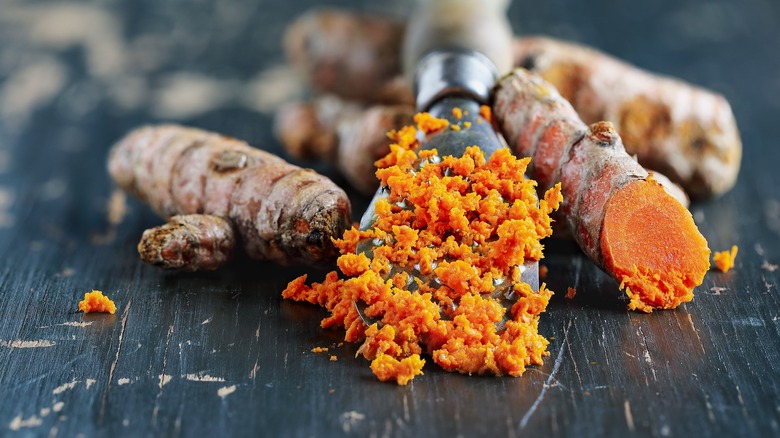
Stephanie Frey/Shutterstock
The beauty of fresh turmeric is that it can be consumed either cooked or raw. And when it comes to raw ingredients, salads tend to steal the show. Try shaving or finely chopping fresh raw turmeric for your next salad. Now, we aren’t talking about one of those “salads” with iceberg lettuce, shredded carrot, and a single whole cherry tomato. No, we mean a real salad that’s heavy, colorful, and loaded to the brim with corresponding, flavor-packed ingredients.
Turmeric can hold its own with kale, but it’s also delicate enough in flavor to pair with butter lettuce. However, turmeric tends to bring out the spiciness of arugula beautifully, complementing its crisp texture. Our favorite yellow root tastes great with other root veggies like carrots, turnips, onions, and beets, so it works with almost any fall harvest salad.
If pairing with bright summer vegetables, be sure to not overload your salad with turmeric. Because of its intensity in color and texture, just a tablespoon should do for a family-sized salad. Its chewy crunch will help to balance the tenderness of your leafy greens. It’s more than just a superfood for your body — turmeric is also super for your taste buds.
Juice turmeric for immunity-boosting shots and cocktails

Ingrid Balabanova/Shutterstock
If the coarse texture of turmeric is too much for you, consider drinking it instead of chewing it. Just like any other fruit or vegetable, fresh turmeric root can easily be juiced. Use a juicer, or blend it with water in a high-speed blender and strain with a cheesecloth. This juice is just as bright as the root, and can be used in a number of drinkable capacities.
For those who enjoy the occasional cocktail, you’ve just found your new secret ingredient to make your drink shine. This turmeric juice will add some layers of complexity to your beverage while balancing any sweetness from fruit juices.
Alternatively, for those on a health kick, try making turmeric-juice shots loaded with superfoods. Balance the spiciness of the turmeric with a little local honey, include some lemon juice, and don’t forget a dash of black pepper. Accentuate the heat by including some cayenne pepper to help open up those nasal passages, and kick-start the metabolism. Add turmeric to any ginger root wellness shot, or let turmeric shine as the main ingredient.
Use it in a marinade
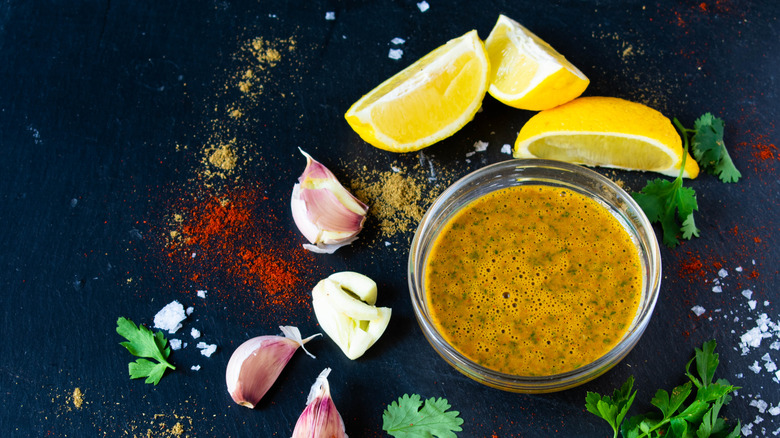
Victoria_Hunter/Shutterstock
Most people have a go-to marinade that makes an appearance as soon as the grill comes out of hibernation. Perhaps it’s store-bought, or maybe it’s a secret recipe that’s been passed down through generations. Whatever the case, it’s never a bad idea to improve upon something you already love. Try adding fresh turmeric to a cup of marinade by simply mincing the root and adding a tablespoon or so. Turmeric will add a hint of spiciness without dominating the flavor, and give the marinade a bit of an earthy undertone to balance any sugars or sweet additions.
While it would taste delicious with a cut of red meat, for aesthetic purposes, turmeric is often paired with white meats, seafood, or tofu. Consider using turmeric in a peppery lemon-based marinade to help tell the story of those bright yellow lemons. Don’t forget to use elements of sweet, fat, salt, and acid in your marinade, and let that baby marinate for at least a few hours. However, if you are able to plan ahead, an overnight soak will work best to help that flavor sink in and give the meat a chance to tenderize.
Flavor your rice with turmeric
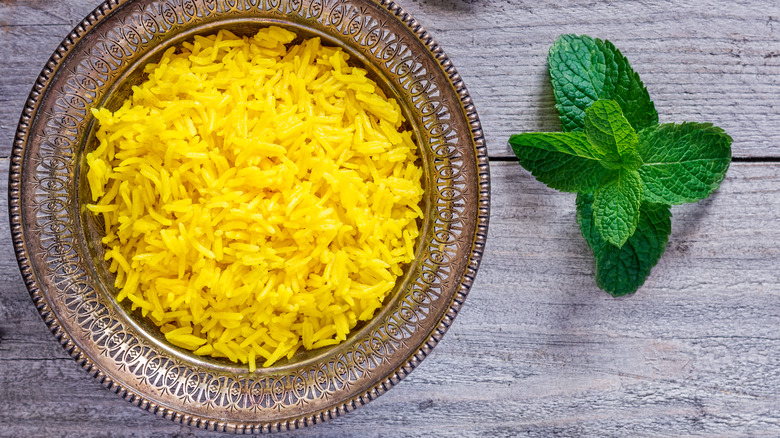
Anamariategzes/Getty Images
Grains are the perfect starchy balance for almost any meat or vegetable. However, there’s nothing worse than rice that has been cooked in unsalted water instead of broth. Even then, a little butter, olive oil, or spices could revive it, but unfortunately, so many grains go unseasoned. Don’t fall into this rut. Instead, use a colorful and flavorful addition to bring life to your rice. Fresh turmeric is here to save the day.
Saffron is a popular addition to rice because of its color and flavor, but it is very expensive. Use turmeric instead. Add just a few tablespoons of minced turmeric, or add a few slices to your cooking water or broth and remove them when the rice is nice and tender. Include black pepper, salt, and a little butter or olive oil.
If you’re trying to avoid certain flavorings, turmeric adds flavor to white rice without salt or oil. That’s right, turmeric holds up well on its own. It provides the perfect umami kick that grains need without stealing the show. Turmeric really has more than just color to offer, and the subtle flavor of the rice allows the root to make an impact.
Warm up with golden milk
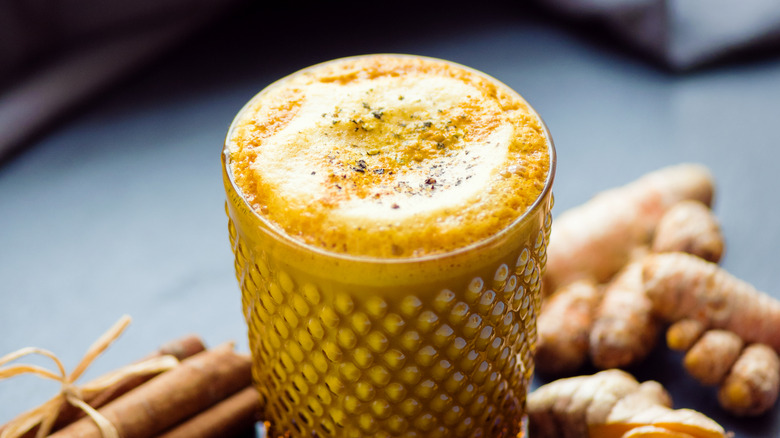
Rocky89/Getty Images
There are plenty of alternatives to coffee out there, but not so many caffeine-free options. Sometimes you just want to curl up with a hot cup of comfort, without the jitters or an overpowering amount of sugar. Herbal tea is great, but doesn’t have the same satisfying impact as a creamy beverage. Turmeric golden milk is an incredible way to sip on a little creamy sunshine without caffeine but with similar antioxidant benefits as coffee.
There are a few ways to brew golden milk. The most simple way is to heat milk or a plant-based milk (often coconut milk) and steep your fresh turmeric in it until it turns a rich golden color. Add a little bit of honey and enjoy. However, golden milk is traditionally made with other flavorings like cinnamon, ginger, black pepper, and vanilla. You can even use coconut oil to thicken it up and create a fattier mouthfeel. This Indian drink is good for your soul, but also for your body. It should be warming, spicy, sweet, and satisfying.
Pickle turmeric or use it when pickling
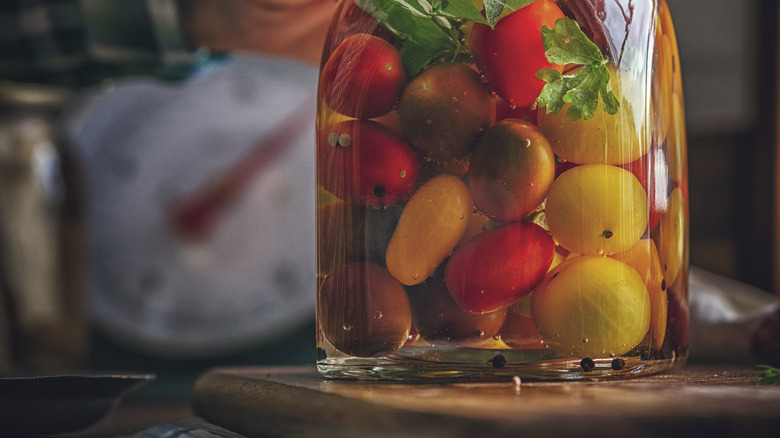
Gmvozd/Getty Images
Pickles are one of those foods that you either love or hate. For pickle lovers, we can’t just stop with cucumbers. Any fruit or vegetable can be pickled, and boy have we tested the limits. Pickled carrots, pickled onions, and pickled beets are famous for being delicious on their own, but also for making an appearance in the pickling process of other vegetables to add flavor and a little earthy sweetness. Turmeric is similar in the sense that it can be pickled and enjoyed on its own, or used to enhance other pickled produce.
If you are pickling turmeric on its own, be sure to cut it into thin slices (think pickled ginger) or into matchstick-sized pieces. The pickling process will help break down some of that aggressive fiber and make it more chewable. Consider adding fresh turmeric to pickled eggs to give them a beautiful bright appearance. Add turmeric to pickled cucumbers to make them even more vibrant. Bits of fresh turmeric can enhance any pickled product you can think of, imparting bright and peppery satisfaction.
Enjoy eggs with turmeric

Anna Fedorova_it/Shutterstock
Although eggs already have a beautiful yellow yolk and umami flavor, who says they can’t be improved with other ingredients? Turmeric is the perfect ingredient to give your morning eggs a boost in both appearance and flavor. Whether you choose to fry, scramble, or enjoy them sunny-side up, eggs and turmeric were meant to be together.
Use turmeric and other herbs and spices while you’re cooking your eggs, instead of sprinkling on these seasonings after cooking them. This allows the spices to incorporate into the egg and become one cohesive unit of flavor. As the turmeric and other spices cook, their flavors enhance the eggs and become aromatic. Enjoy a kitchen filled with smells that will lure even teenagers out of bed in the morning. The entire experience creates a major upgrade, and with turmeric-flavored eggs, you’ll never be tired of your morning breakfast ritual again.







